Importance of Effective Communication in Executing Strategies
VerifiedAdded on 2023/06/09
|9
|1501
|78
AI Summary
This article discusses the importance of effective communication in executing strategies in the 21st century. It covers the role of vision, culture, and stakeholders in bringing a transition from traditional communication to modern communication. The article also includes analysis of three related articles.
Contribute Materials
Your contribution can guide someone’s learning journey. Share your
documents today.
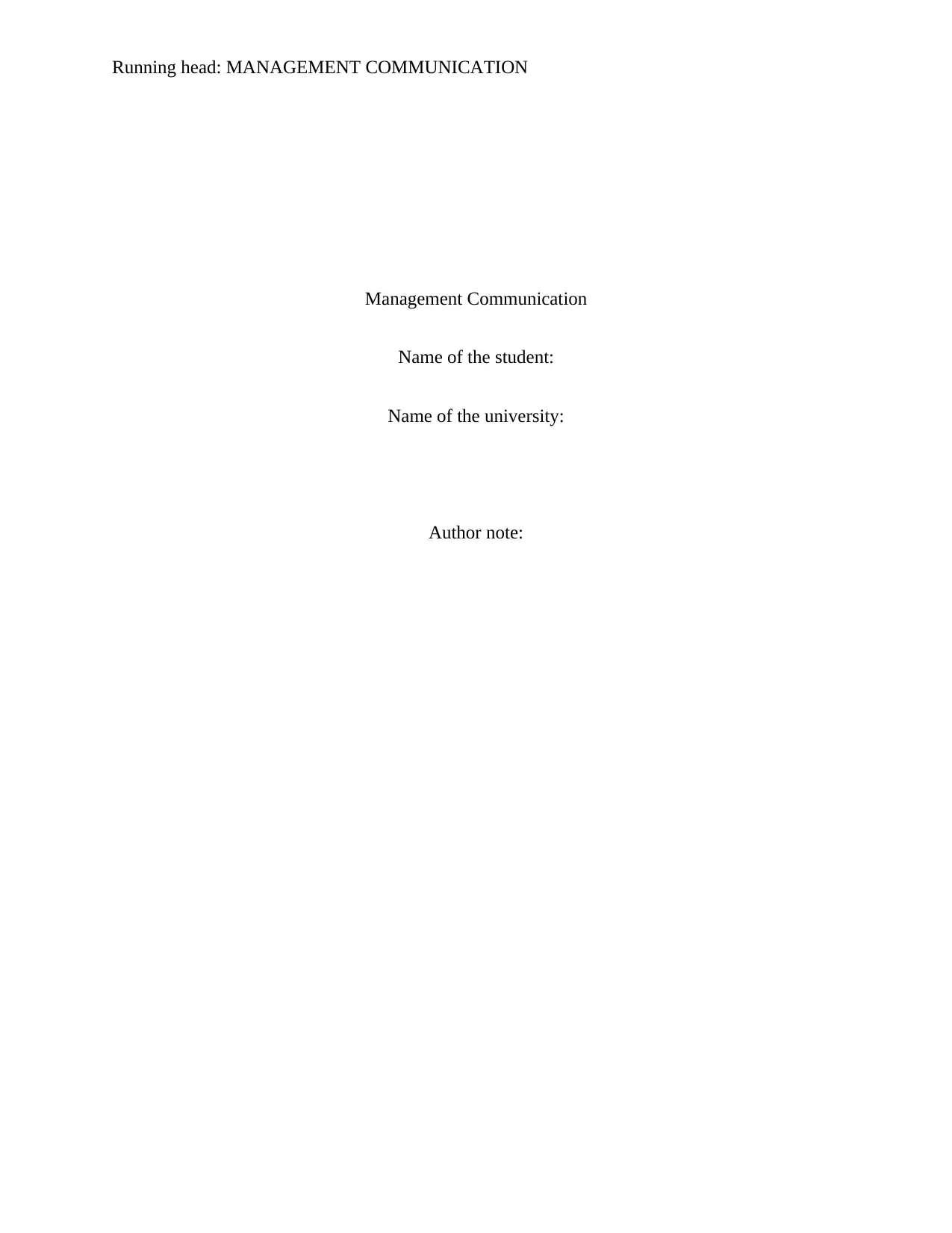
Running head: MANAGEMENT COMMUNICATION
Management Communication
Name of the student:
Name of the university:
Author note:
Management Communication
Name of the student:
Name of the university:
Author note:
Secure Best Marks with AI Grader
Need help grading? Try our AI Grader for instant feedback on your assignments.
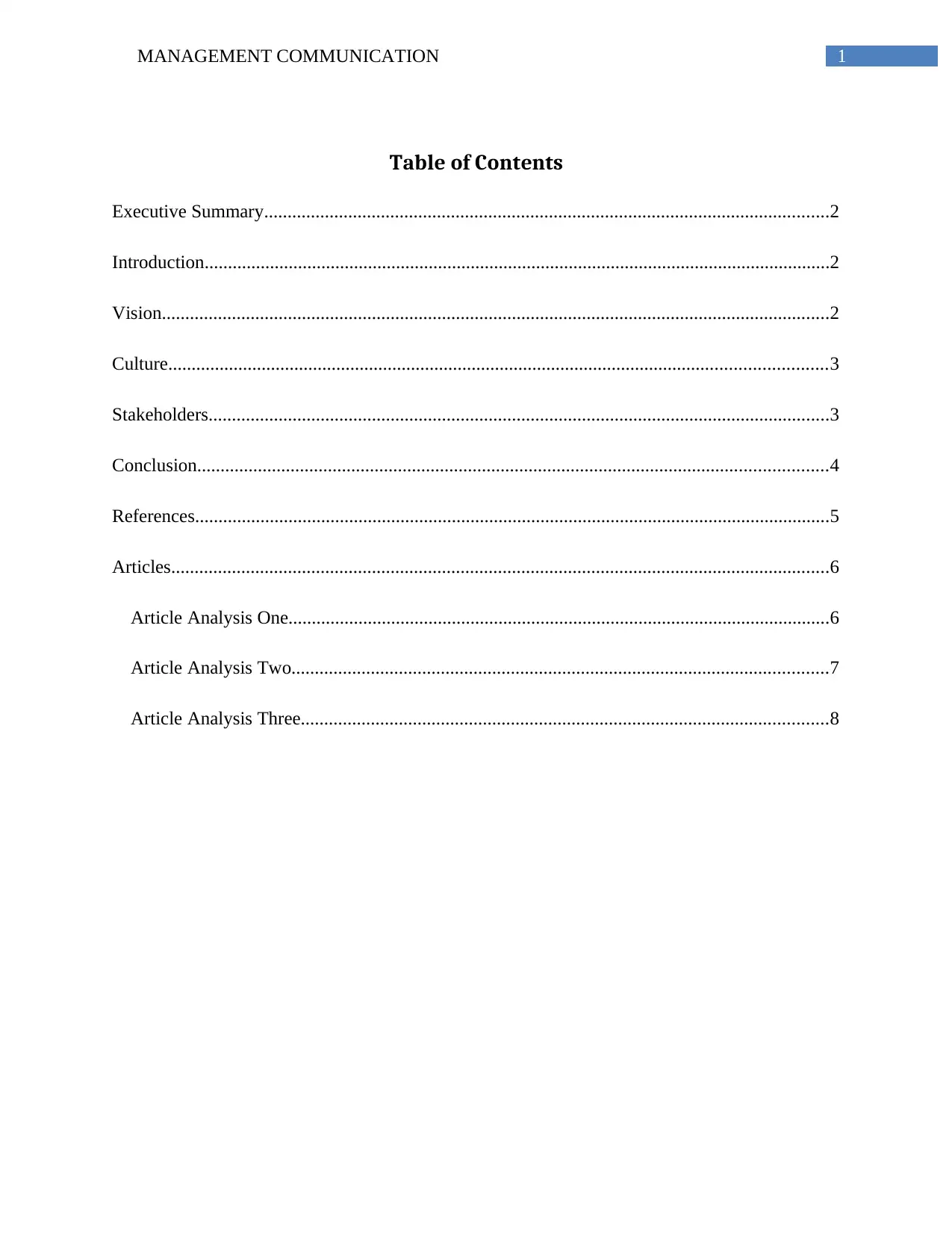
1MANAGEMENT COMMUNICATION
Table of Contents
Executive Summary.........................................................................................................................2
Introduction......................................................................................................................................2
Vision...............................................................................................................................................2
Culture.............................................................................................................................................3
Stakeholders.....................................................................................................................................3
Conclusion.......................................................................................................................................4
References........................................................................................................................................5
Articles.............................................................................................................................................6
Article Analysis One....................................................................................................................6
Article Analysis Two...................................................................................................................7
Article Analysis Three.................................................................................................................8
Table of Contents
Executive Summary.........................................................................................................................2
Introduction......................................................................................................................................2
Vision...............................................................................................................................................2
Culture.............................................................................................................................................3
Stakeholders.....................................................................................................................................3
Conclusion.......................................................................................................................................4
References........................................................................................................................................5
Articles.............................................................................................................................................6
Article Analysis One....................................................................................................................6
Article Analysis Two...................................................................................................................7
Article Analysis Three.................................................................................................................8
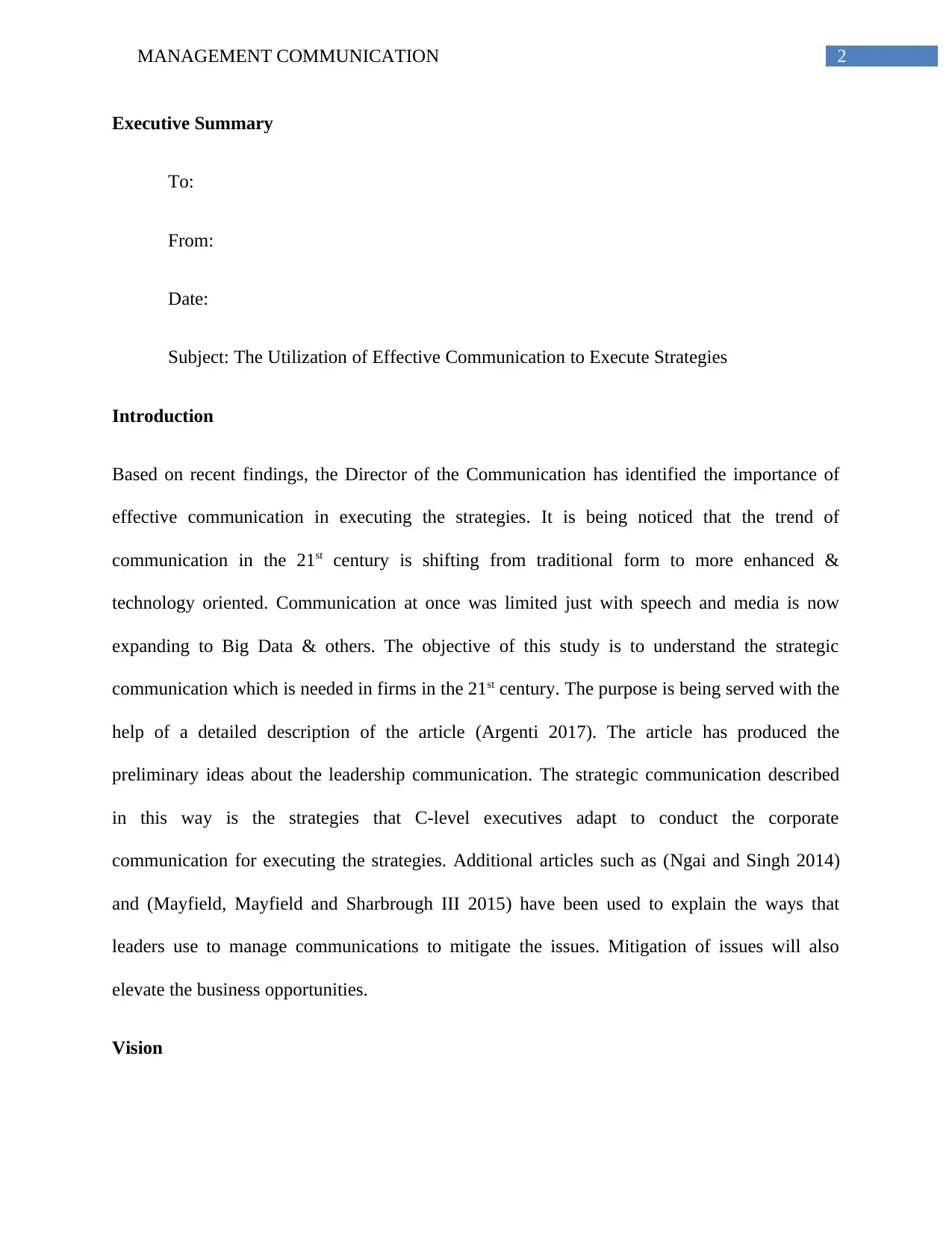
2MANAGEMENT COMMUNICATION
Executive Summary
To:
From:
Date:
Subject: The Utilization of Effective Communication to Execute Strategies
Introduction
Based on recent findings, the Director of the Communication has identified the importance of
effective communication in executing the strategies. It is being noticed that the trend of
communication in the 21st century is shifting from traditional form to more enhanced &
technology oriented. Communication at once was limited just with speech and media is now
expanding to Big Data & others. The objective of this study is to understand the strategic
communication which is needed in firms in the 21st century. The purpose is being served with the
help of a detailed description of the article (Argenti 2017). The article has produced the
preliminary ideas about the leadership communication. The strategic communication described
in this way is the strategies that C-level executives adapt to conduct the corporate
communication for executing the strategies. Additional articles such as (Ngai and Singh 2014)
and (Mayfield, Mayfield and Sharbrough III 2015) have been used to explain the ways that
leaders use to manage communications to mitigate the issues. Mitigation of issues will also
elevate the business opportunities.
Vision
Executive Summary
To:
From:
Date:
Subject: The Utilization of Effective Communication to Execute Strategies
Introduction
Based on recent findings, the Director of the Communication has identified the importance of
effective communication in executing the strategies. It is being noticed that the trend of
communication in the 21st century is shifting from traditional form to more enhanced &
technology oriented. Communication at once was limited just with speech and media is now
expanding to Big Data & others. The objective of this study is to understand the strategic
communication which is needed in firms in the 21st century. The purpose is being served with the
help of a detailed description of the article (Argenti 2017). The article has produced the
preliminary ideas about the leadership communication. The strategic communication described
in this way is the strategies that C-level executives adapt to conduct the corporate
communication for executing the strategies. Additional articles such as (Ngai and Singh 2014)
and (Mayfield, Mayfield and Sharbrough III 2015) have been used to explain the ways that
leaders use to manage communications to mitigate the issues. Mitigation of issues will also
elevate the business opportunities.
Vision
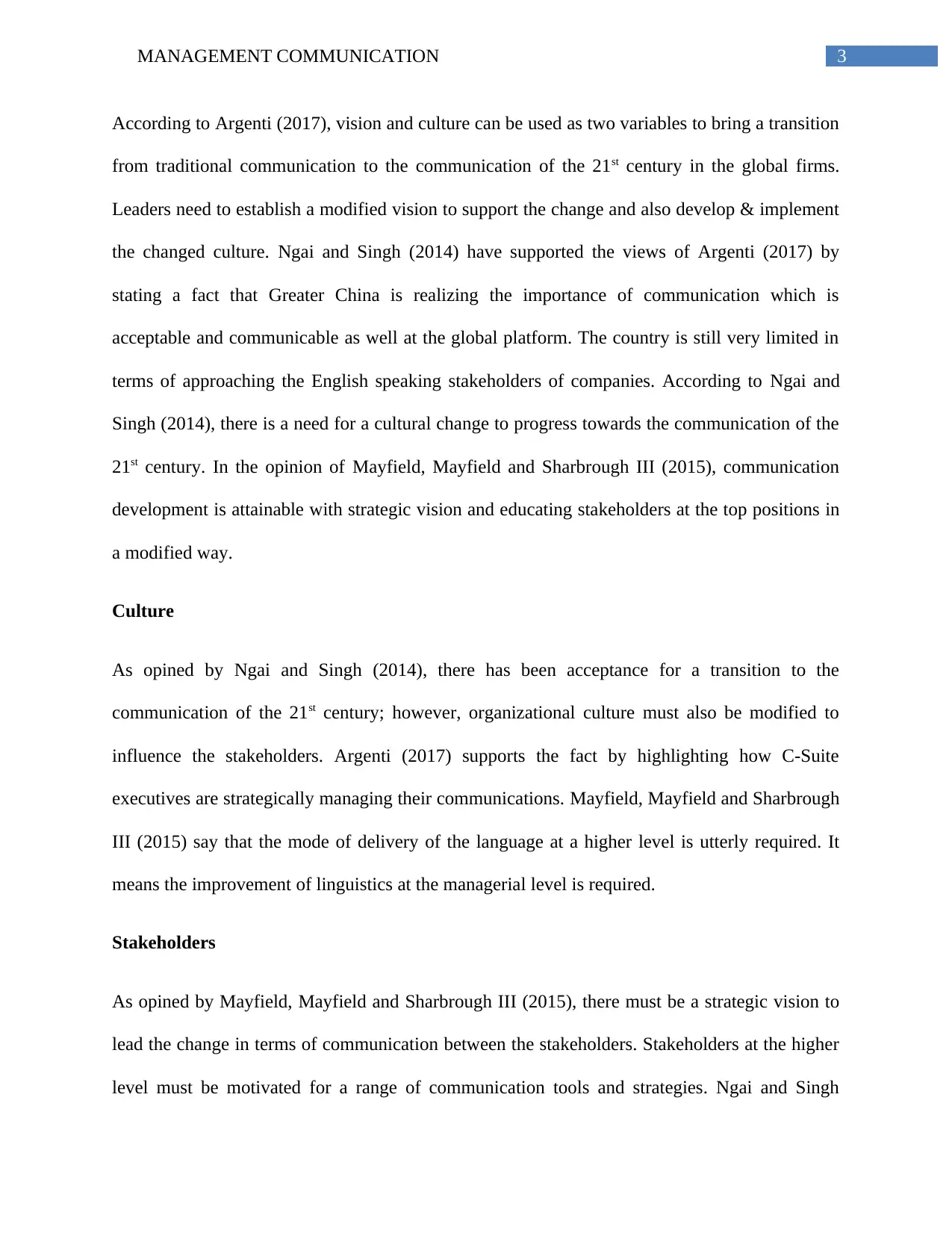
3MANAGEMENT COMMUNICATION
According to Argenti (2017), vision and culture can be used as two variables to bring a transition
from traditional communication to the communication of the 21st century in the global firms.
Leaders need to establish a modified vision to support the change and also develop & implement
the changed culture. Ngai and Singh (2014) have supported the views of Argenti (2017) by
stating a fact that Greater China is realizing the importance of communication which is
acceptable and communicable as well at the global platform. The country is still very limited in
terms of approaching the English speaking stakeholders of companies. According to Ngai and
Singh (2014), there is a need for a cultural change to progress towards the communication of the
21st century. In the opinion of Mayfield, Mayfield and Sharbrough III (2015), communication
development is attainable with strategic vision and educating stakeholders at the top positions in
a modified way.
Culture
As opined by Ngai and Singh (2014), there has been acceptance for a transition to the
communication of the 21st century; however, organizational culture must also be modified to
influence the stakeholders. Argenti (2017) supports the fact by highlighting how C-Suite
executives are strategically managing their communications. Mayfield, Mayfield and Sharbrough
III (2015) say that the mode of delivery of the language at a higher level is utterly required. It
means the improvement of linguistics at the managerial level is required.
Stakeholders
As opined by Mayfield, Mayfield and Sharbrough III (2015), there must be a strategic vision to
lead the change in terms of communication between the stakeholders. Stakeholders at the higher
level must be motivated for a range of communication tools and strategies. Ngai and Singh
According to Argenti (2017), vision and culture can be used as two variables to bring a transition
from traditional communication to the communication of the 21st century in the global firms.
Leaders need to establish a modified vision to support the change and also develop & implement
the changed culture. Ngai and Singh (2014) have supported the views of Argenti (2017) by
stating a fact that Greater China is realizing the importance of communication which is
acceptable and communicable as well at the global platform. The country is still very limited in
terms of approaching the English speaking stakeholders of companies. According to Ngai and
Singh (2014), there is a need for a cultural change to progress towards the communication of the
21st century. In the opinion of Mayfield, Mayfield and Sharbrough III (2015), communication
development is attainable with strategic vision and educating stakeholders at the top positions in
a modified way.
Culture
As opined by Ngai and Singh (2014), there has been acceptance for a transition to the
communication of the 21st century; however, organizational culture must also be modified to
influence the stakeholders. Argenti (2017) supports the fact by highlighting how C-Suite
executives are strategically managing their communications. Mayfield, Mayfield and Sharbrough
III (2015) say that the mode of delivery of the language at a higher level is utterly required. It
means the improvement of linguistics at the managerial level is required.
Stakeholders
As opined by Mayfield, Mayfield and Sharbrough III (2015), there must be a strategic vision to
lead the change in terms of communication between the stakeholders. Stakeholders at the higher
level must be motivated for a range of communication tools and strategies. Ngai and Singh
Secure Best Marks with AI Grader
Need help grading? Try our AI Grader for instant feedback on your assignments.
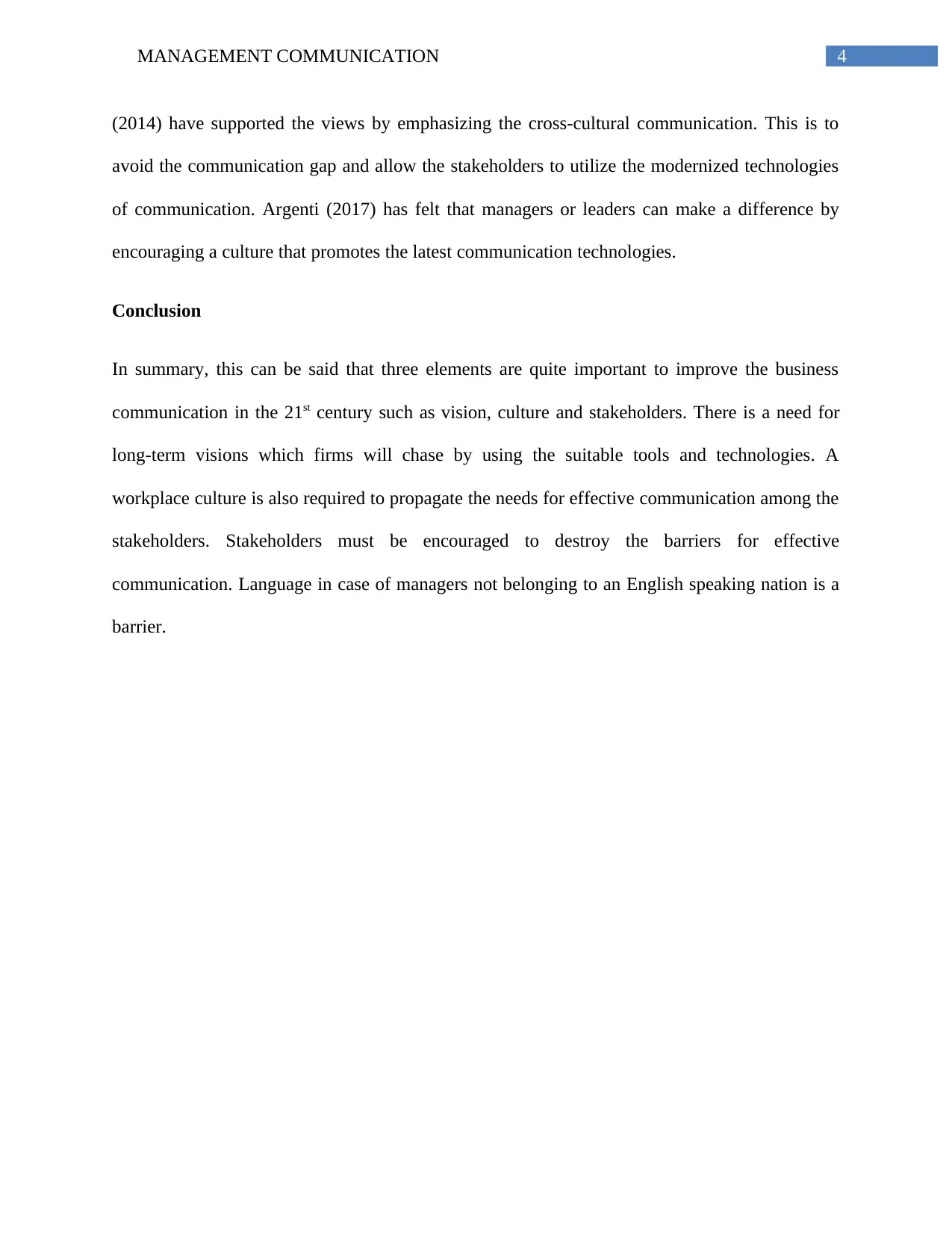
4MANAGEMENT COMMUNICATION
(2014) have supported the views by emphasizing the cross-cultural communication. This is to
avoid the communication gap and allow the stakeholders to utilize the modernized technologies
of communication. Argenti (2017) has felt that managers or leaders can make a difference by
encouraging a culture that promotes the latest communication technologies.
Conclusion
In summary, this can be said that three elements are quite important to improve the business
communication in the 21st century such as vision, culture and stakeholders. There is a need for
long-term visions which firms will chase by using the suitable tools and technologies. A
workplace culture is also required to propagate the needs for effective communication among the
stakeholders. Stakeholders must be encouraged to destroy the barriers for effective
communication. Language in case of managers not belonging to an English speaking nation is a
barrier.
(2014) have supported the views by emphasizing the cross-cultural communication. This is to
avoid the communication gap and allow the stakeholders to utilize the modernized technologies
of communication. Argenti (2017) has felt that managers or leaders can make a difference by
encouraging a culture that promotes the latest communication technologies.
Conclusion
In summary, this can be said that three elements are quite important to improve the business
communication in the 21st century such as vision, culture and stakeholders. There is a need for
long-term visions which firms will chase by using the suitable tools and technologies. A
workplace culture is also required to propagate the needs for effective communication among the
stakeholders. Stakeholders must be encouraged to destroy the barriers for effective
communication. Language in case of managers not belonging to an English speaking nation is a
barrier.
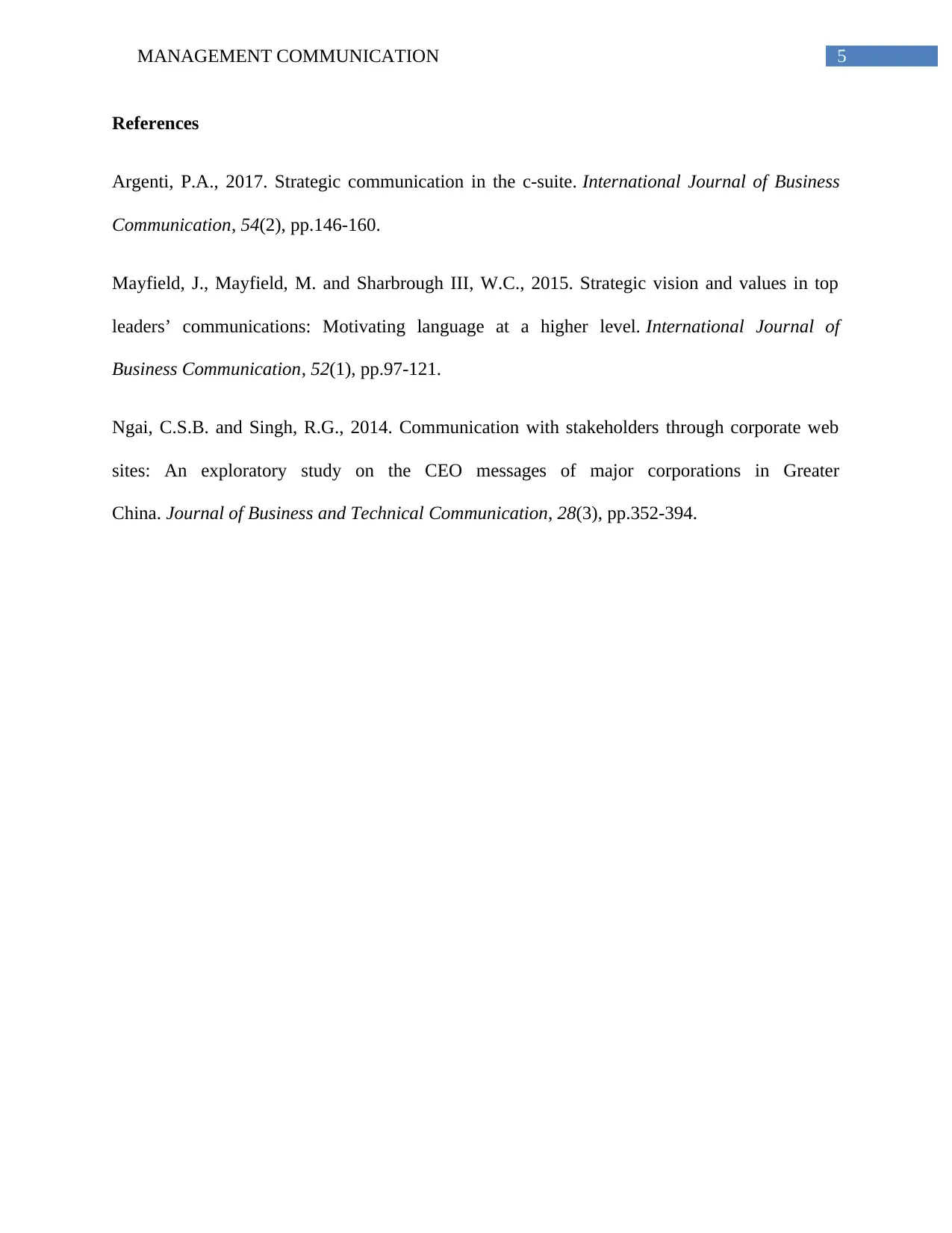
5MANAGEMENT COMMUNICATION
References
Argenti, P.A., 2017. Strategic communication in the c-suite. International Journal of Business
Communication, 54(2), pp.146-160.
Mayfield, J., Mayfield, M. and Sharbrough III, W.C., 2015. Strategic vision and values in top
leaders’ communications: Motivating language at a higher level. International Journal of
Business Communication, 52(1), pp.97-121.
Ngai, C.S.B. and Singh, R.G., 2014. Communication with stakeholders through corporate web
sites: An exploratory study on the CEO messages of major corporations in Greater
China. Journal of Business and Technical Communication, 28(3), pp.352-394.
References
Argenti, P.A., 2017. Strategic communication in the c-suite. International Journal of Business
Communication, 54(2), pp.146-160.
Mayfield, J., Mayfield, M. and Sharbrough III, W.C., 2015. Strategic vision and values in top
leaders’ communications: Motivating language at a higher level. International Journal of
Business Communication, 52(1), pp.97-121.
Ngai, C.S.B. and Singh, R.G., 2014. Communication with stakeholders through corporate web
sites: An exploratory study on the CEO messages of major corporations in Greater
China. Journal of Business and Technical Communication, 28(3), pp.352-394.
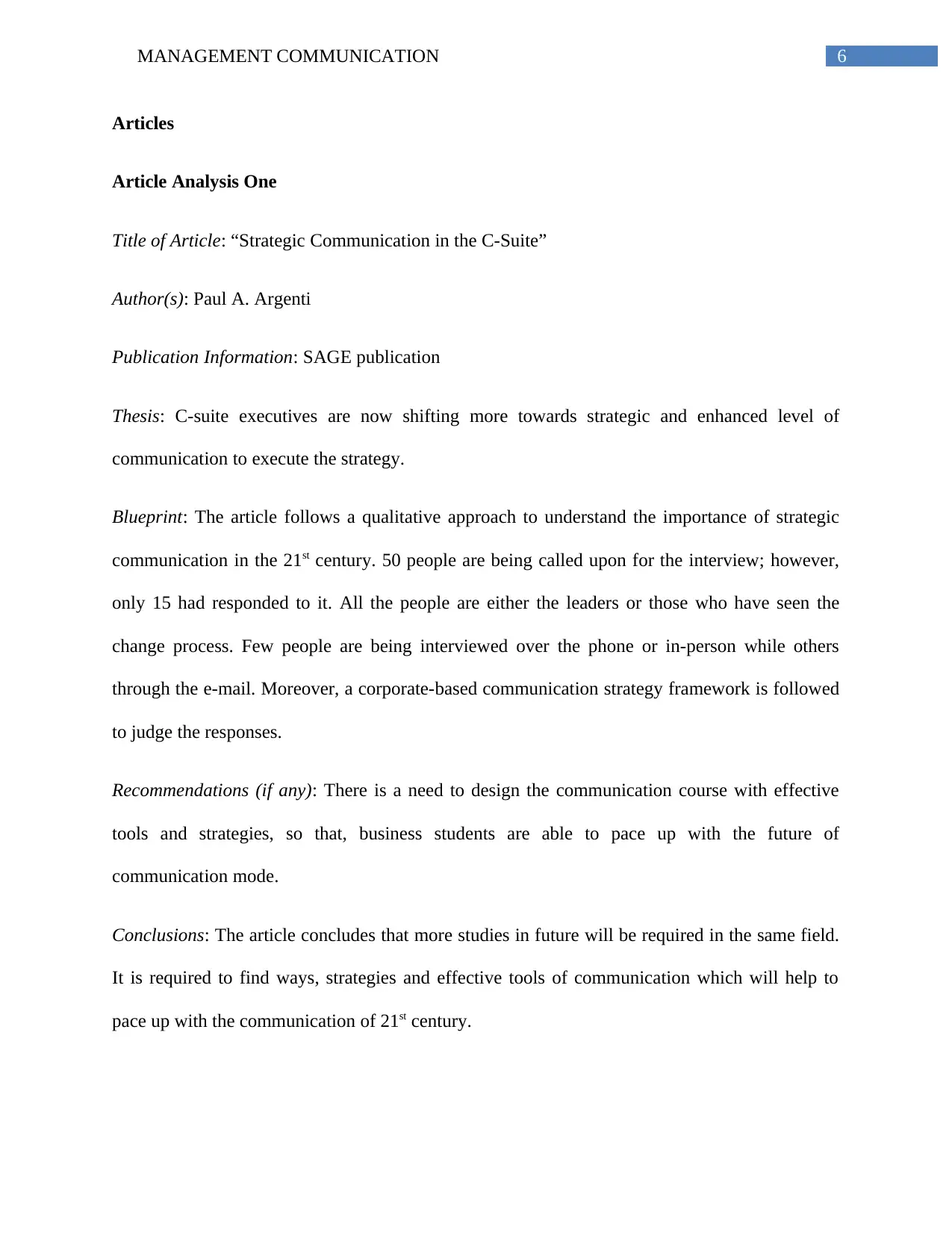
6MANAGEMENT COMMUNICATION
Articles
Article Analysis One
Title of Article: “Strategic Communication in the C-Suite”
Author(s): Paul A. Argenti
Publication Information: SAGE publication
Thesis: C-suite executives are now shifting more towards strategic and enhanced level of
communication to execute the strategy.
Blueprint: The article follows a qualitative approach to understand the importance of strategic
communication in the 21st century. 50 people are being called upon for the interview; however,
only 15 had responded to it. All the people are either the leaders or those who have seen the
change process. Few people are being interviewed over the phone or in-person while others
through the e-mail. Moreover, a corporate-based communication strategy framework is followed
to judge the responses.
Recommendations (if any): There is a need to design the communication course with effective
tools and strategies, so that, business students are able to pace up with the future of
communication mode.
Conclusions: The article concludes that more studies in future will be required in the same field.
It is required to find ways, strategies and effective tools of communication which will help to
pace up with the communication of 21st century.
Articles
Article Analysis One
Title of Article: “Strategic Communication in the C-Suite”
Author(s): Paul A. Argenti
Publication Information: SAGE publication
Thesis: C-suite executives are now shifting more towards strategic and enhanced level of
communication to execute the strategy.
Blueprint: The article follows a qualitative approach to understand the importance of strategic
communication in the 21st century. 50 people are being called upon for the interview; however,
only 15 had responded to it. All the people are either the leaders or those who have seen the
change process. Few people are being interviewed over the phone or in-person while others
through the e-mail. Moreover, a corporate-based communication strategy framework is followed
to judge the responses.
Recommendations (if any): There is a need to design the communication course with effective
tools and strategies, so that, business students are able to pace up with the future of
communication mode.
Conclusions: The article concludes that more studies in future will be required in the same field.
It is required to find ways, strategies and effective tools of communication which will help to
pace up with the communication of 21st century.
Paraphrase This Document
Need a fresh take? Get an instant paraphrase of this document with our AI Paraphraser
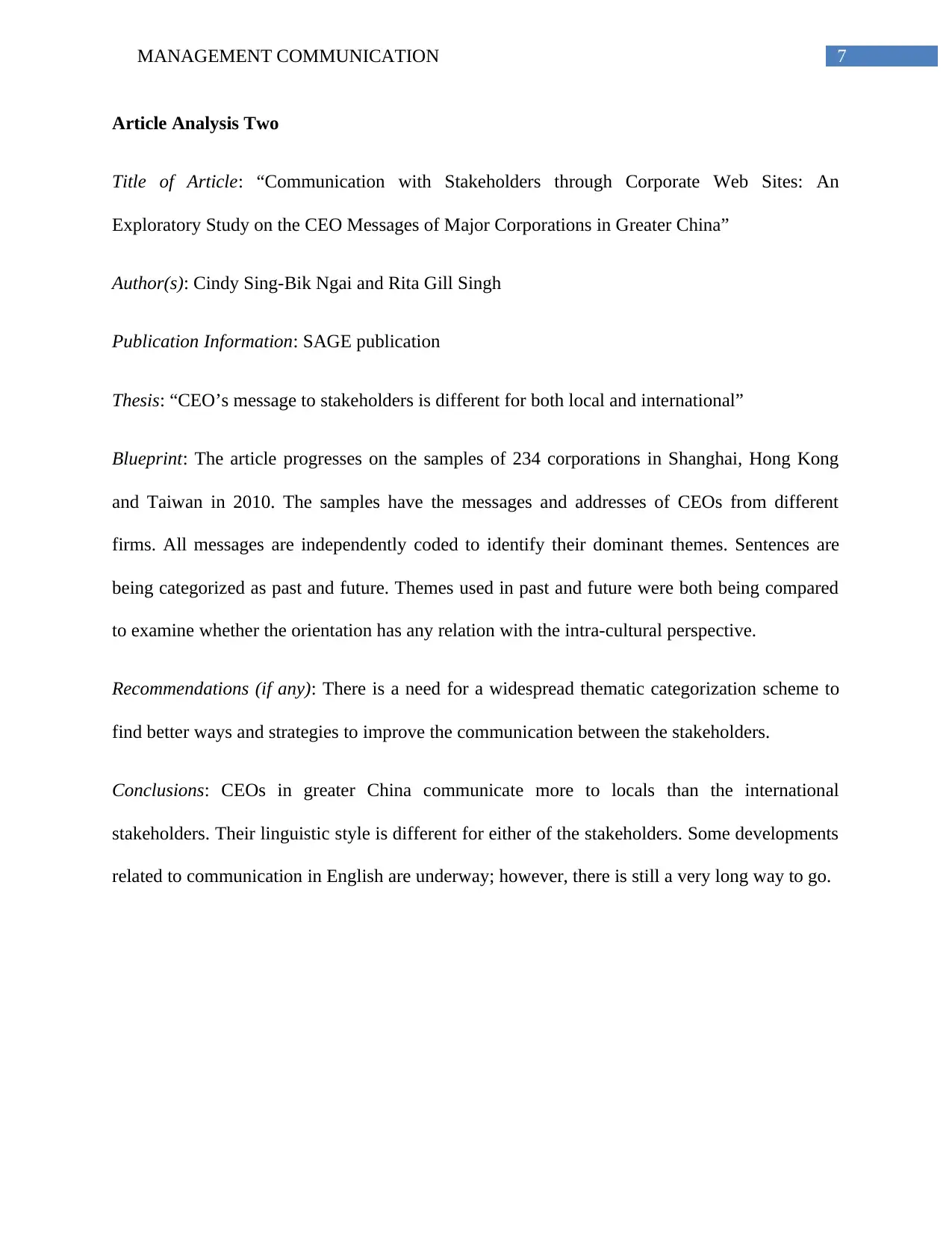
7MANAGEMENT COMMUNICATION
Article Analysis Two
Title of Article: “Communication with Stakeholders through Corporate Web Sites: An
Exploratory Study on the CEO Messages of Major Corporations in Greater China”
Author(s): Cindy Sing-Bik Ngai and Rita Gill Singh
Publication Information: SAGE publication
Thesis: “CEO’s message to stakeholders is different for both local and international”
Blueprint: The article progresses on the samples of 234 corporations in Shanghai, Hong Kong
and Taiwan in 2010. The samples have the messages and addresses of CEOs from different
firms. All messages are independently coded to identify their dominant themes. Sentences are
being categorized as past and future. Themes used in past and future were both being compared
to examine whether the orientation has any relation with the intra-cultural perspective.
Recommendations (if any): There is a need for a widespread thematic categorization scheme to
find better ways and strategies to improve the communication between the stakeholders.
Conclusions: CEOs in greater China communicate more to locals than the international
stakeholders. Their linguistic style is different for either of the stakeholders. Some developments
related to communication in English are underway; however, there is still a very long way to go.
Article Analysis Two
Title of Article: “Communication with Stakeholders through Corporate Web Sites: An
Exploratory Study on the CEO Messages of Major Corporations in Greater China”
Author(s): Cindy Sing-Bik Ngai and Rita Gill Singh
Publication Information: SAGE publication
Thesis: “CEO’s message to stakeholders is different for both local and international”
Blueprint: The article progresses on the samples of 234 corporations in Shanghai, Hong Kong
and Taiwan in 2010. The samples have the messages and addresses of CEOs from different
firms. All messages are independently coded to identify their dominant themes. Sentences are
being categorized as past and future. Themes used in past and future were both being compared
to examine whether the orientation has any relation with the intra-cultural perspective.
Recommendations (if any): There is a need for a widespread thematic categorization scheme to
find better ways and strategies to improve the communication between the stakeholders.
Conclusions: CEOs in greater China communicate more to locals than the international
stakeholders. Their linguistic style is different for either of the stakeholders. Some developments
related to communication in English are underway; however, there is still a very long way to go.
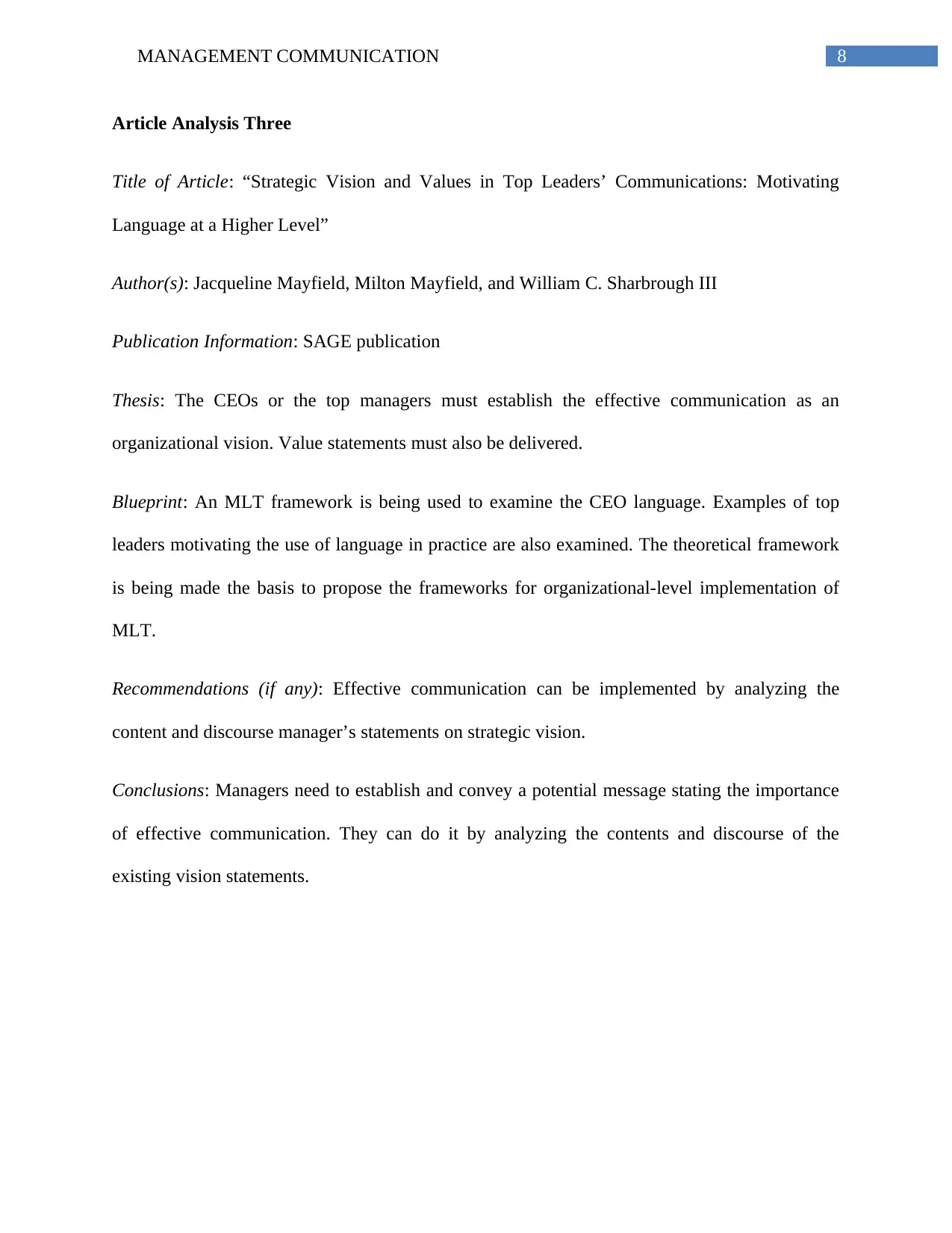
8MANAGEMENT COMMUNICATION
Article Analysis Three
Title of Article: “Strategic Vision and Values in Top Leaders’ Communications: Motivating
Language at a Higher Level”
Author(s): Jacqueline Mayfield, Milton Mayfield, and William C. Sharbrough III
Publication Information: SAGE publication
Thesis: The CEOs or the top managers must establish the effective communication as an
organizational vision. Value statements must also be delivered.
Blueprint: An MLT framework is being used to examine the CEO language. Examples of top
leaders motivating the use of language in practice are also examined. The theoretical framework
is being made the basis to propose the frameworks for organizational-level implementation of
MLT.
Recommendations (if any): Effective communication can be implemented by analyzing the
content and discourse manager’s statements on strategic vision.
Conclusions: Managers need to establish and convey a potential message stating the importance
of effective communication. They can do it by analyzing the contents and discourse of the
existing vision statements.
Article Analysis Three
Title of Article: “Strategic Vision and Values in Top Leaders’ Communications: Motivating
Language at a Higher Level”
Author(s): Jacqueline Mayfield, Milton Mayfield, and William C. Sharbrough III
Publication Information: SAGE publication
Thesis: The CEOs or the top managers must establish the effective communication as an
organizational vision. Value statements must also be delivered.
Blueprint: An MLT framework is being used to examine the CEO language. Examples of top
leaders motivating the use of language in practice are also examined. The theoretical framework
is being made the basis to propose the frameworks for organizational-level implementation of
MLT.
Recommendations (if any): Effective communication can be implemented by analyzing the
content and discourse manager’s statements on strategic vision.
Conclusions: Managers need to establish and convey a potential message stating the importance
of effective communication. They can do it by analyzing the contents and discourse of the
existing vision statements.
1 out of 9
Related Documents
Your All-in-One AI-Powered Toolkit for Academic Success.
+13062052269
info@desklib.com
Available 24*7 on WhatsApp / Email
![[object Object]](/_next/static/media/star-bottom.7253800d.svg)
Unlock your academic potential
© 2024 | Zucol Services PVT LTD | All rights reserved.



